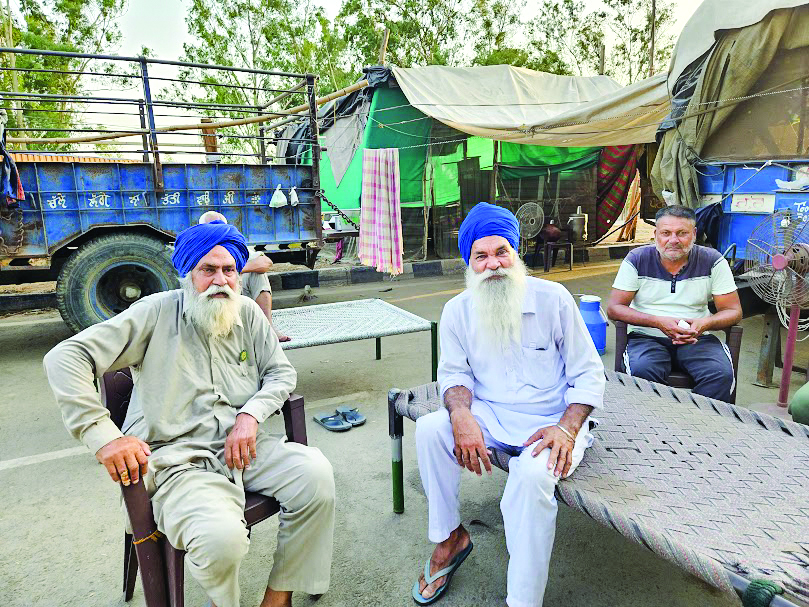Chandigarh: Nine-month-long protest disrupts key highway, blocking the vital link between Delhi, Punjab, Haryana and Jammu & Kashmir.
The farmers’ agitation at the Shambhu border between Haryana and Punjab on National Highway 44 (NH-44), now in its ninth month, has led to a prolonged deadlock on one of India’s busiest highways.
This standoff continues to disrupt traffic flow between Delhi, Punjab, and Jammu and Kashmir, significantly impacting movement along this vital route. With over 50,000 vehicles typically using this essential route daily, the blockade has strained local businesses, interrupted commuters, and showcased the persistence of the farmers, who refuse to back down despite dwindling numbers.
Since 13 February, when the current wave of the protest began, the Haryana police have maintained a blockade, preventing the farmers from advancing toward Delhi, where they hope to rekindle the momentum of their 2020-21 protests. The farmers demand a legal guarantee on minimum support price (MSP) for all 23 notified crops—a promise they believe was left unfulfilled from the previous 2020-21 protests—as well as other key concessions such as loan waivers and pension schemes for farmers and labourers.
Despite the commitment of those at the Shambhu border, the prolonged standstill has started wearing down both the protestors and local stakeholders. Many farmers have been living in tractor trailers converted into makeshift shelters, and though fewer in number, they continue to hold their ground. “There is no way back. Either we move forward or the government meets our demands. We can’t go back now,” said Baldev Singh, a farmer from Amritsar, illustrating the mood among the remaining protestors.
The blockade on NH-44 has heavily impacted those who rely on the highway for commerce and commuting. Small businesses, dhaba owners, shopkeepers, and roadside vendors along the route have suffered significant financial losses, with many losing hope of returning to regular operations. “Our earnings have been hit badly because there are no trucks on this highway,” lamented Gurmeet Singh, a local shopkeeper who works at an eatery located along the blocked route.
Moreover, the continuous closure has inconvenienced thousands of daily commuters who depend on the highway for travel between Punjab, Haryana, and Delhi. The once-bustling route now resembles a standstill, with barricades erected by the Haryana police acting as a reminder of the tense standoff between protestors and authorities. This disruption has severed connectivity between two key cities—Ambala in Haryana and Patiala in Punjab—significantly impacting both regions. Ambala, renowned as a textile hub, and Patiala, known for its agricultural implements, are home to thousands of businesses now bearing the brunt of the blockade. Additionally, the diversion of heavy traffic onto smaller link roads has worsened conditions for villagers, as these roads are damaged and make travel challenging for residents trying to reach their destinations.
The agitation has been jointly organized by the Samyukta Kisan Morcha (Non-Political) and Kisan Mazdoor Morcha (KMM), but dwindling support, both in terms of numbers and public backing, has added new challenges for the movement. Over time, internal divisions among farmer leaders have become apparent. Some big faces of the 2020-21 protests, had criticized them as “inexperienced” or “uncommitted,” and attempts to consolidate support from other unions have largely failed, with key groups like Bharatiya Kisan Union (Charuni) showing limited involvement this time around.
Farmer leaders had pinned their hopes on the Haryana Assembly elections, anticipating that a BJP defeat could lead to the lifting of the blockade. However, the election results came as a shock, with the BJP retaining power in Haryana, dashing their hopes for any immediate relief from the blockade.
Meanwhile, the Union government and the Haryana government have so far taken a firm stand, with barricades positioned over 250 kilometres away from Delhi’s Singhu border, the original epicentre of the 2020-21 protests. In February, the government made an offer to guarantee MSP for five additional crops, but this proposal, which hinges on reducing paddy and wheat cultivation, has not been enough to satisfy the farmers.
Former Union Agriculture Minister Arjun Munda’s outreach in February for further dialogue raised temporary hopes among the protestors. However, in the nine months since, no follow-up meetings have been held, leaving the farmers feeling increasingly ignored and marginalised. The protestors’ distrust deepened when the farmer leaders rejected the Supreme Court-appointed committee
Looking ahead, farmer leaders remain steadfast in their resolve. “Talks are the only solution to any standoff. Even if the barricades are removed, we will hold talks in Delhi. Now it is up to the government how long it wants us to continue the protest,” said Abhimanyu Kohar, a prominent SKM (Non Political) leader.
With farmers camped at Shambhu and Khanauri borders, the agitation remains a potential flashpoint. Though the number of protestors has dwindled, leaders plan to intensify efforts to mobilize support in the coming months. In the words of Kohar, “We will not return empty-handed, and the agitation will continue until our demands are met.”
Adding to the challenges, most protesters currently at Shambhu are elderly, with younger farmers having left the site temporarily for the paddy harvesting season and festivals. Worried over the falling strength, now farmer leaders have planned a meeting post-5 November to discuss future strategies, hoping to regroup and regain strength for the ongoing fight.

